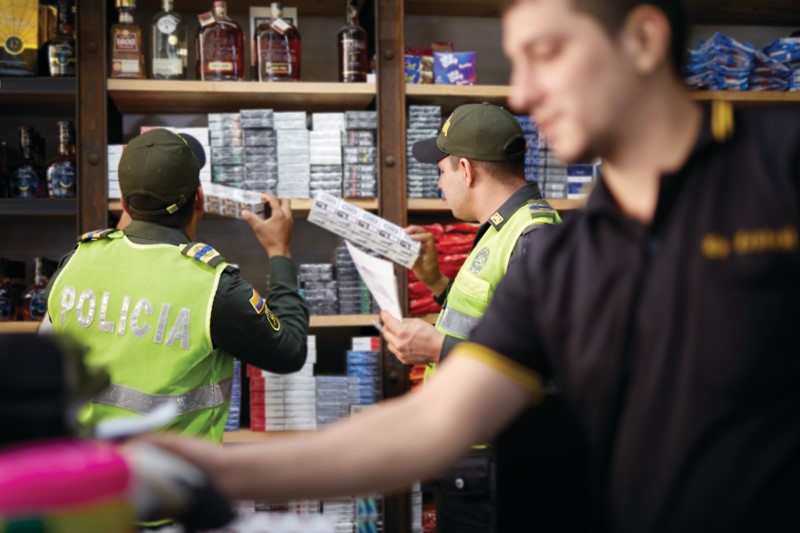
Collaboration is key to fighting illicit trade at sea
17 may 2018

On April 26th, the U.S. National Intellectual Property Rights Coordination Centre (NIPRC) signed a historic Declaration of Intent (DOI) to Prevent the Maritime Transport of Counterfeit Goods. This meant that law-enforcement officials joined 12 of the world’s most prominent brands, six of the largest shipping companies, and three of the most expansive anti-illicit trade networks in their efforts to combat the prevalence of maritime illicit trade.
To get a sense of the issues at hand in the shipping industry, and the importance of collaboration in addressing them, STOP ILLEGAL sat down with Laurent Audaz, Head of P&I Insurance, Legal and Claims at MSC Mediterranean Shipping Company SA—the second largest shipping company in the world.
STOP ILLEGAL: How significant is illicit trade in the shipping industry?
Laurent Audaz: The fact is we simply don’t know. We do know that every year we will be carrying, very much against our wishes, some illicit goods, but the exact numbers we don’t know.
90 percent of global trade is carried out at sea. MSC alone carried 18 million containers last year and if you take the three largest companies together —Maersk, MSC, and CMA CGM—we are looking at roughly 50 million containers. So we are talking about huge volumes. And this sheer volume makes illicit trade very difficult to deal with for our industry.
First of all, and most obviously, it is impossible to check the cargo of every single one of those 50 million containers. We would need an army of thousands of people to be present at all the ports where our ships berth if we wanted to check everything that is being loaded onto our ships or the ships of our contractors and partners. It’s just not materially feasible. But it’s not just about volumes. It’s also about access.
For totally understandable reasons, many of our customers aren’t prepared to give us access to the full contracts which underlie the transportation of their goods. And then even if we were able to see what is inside, it wouldn’t necessarily be clear to us what is fake and what isn’t. The IP rights, licenses, and trademarks documentation are not brought to our knowledge. As a consequence, we could be standing in front of a shipment of a world-famous brand of shoes and the only people who could tell whether they were genuine or not would be the forensic experts from that sportswear company. Often fakes are indistinguishable to the naked untrained eye.
So for all these reasons and many others, tackling illicit trade in the shipping industry is very difficult. It all makes collaboration across the entire supply chain incredibly important so we can identify and target the cause of the problem: the counterfeiters themselves.
STOP ILLEGAL: What are the most important steps needed in tackling illicit trade?
Laurent Audaz: Collaboration is key. This is why bringing together signatories from different industries has had such a positive impact. We are starting to see a pooling of the burden of illicit trade and cooperation in finding a solution. But there are still many areas that could be improved.
Fundamentally, we need reinforcement from law authorities. The recent signing by the US NIPRC of the DOI to Prevent the Maritime Transport of Counterfeit Goods is a great move. It gives us a much greater ability to crack down on those shipping illicit goods. But we really hope to see more law authorities join in on the fight against illicit trade. We would also like to see this coupled with greater investment in border control (for exports as well as for imports), which would allow them to make more checks and gather better intelligence.
The second most important factor is cost. In most countries, the fees involved in the storage and disposal of counterfeit goods are left with the brand holders as from the date of the customs seizure. As a result, many brand holders will prefer to release the counterfeited goods rather than face these costs. This is perfectly understandable from a financial viewpoint but quite counterproductive in terms of fighting piracy and leaves shipping lines with important unrecoverable costs.
In our view, the pooling of storing and disposal costs would greatly help the entire logistics chain in cracking down on illicit trade. Hubs of storage and disposal could be created at various locations around the globe where the brand holders could secure preferential tariffs, hence reducing the financial pressure on them.
To make this possible though, brand holders need to first be able to transport goods beyond the place where they are initially identified as illicit. And at the moment they aren’t allowed to do that legally. From the moment cargo has been identified as counterfeit you cannot transport it further or you then become a smuggler yourself. If I find a cargo, let’s say in Italy, I would be unable to move that cargo closer to the brand-owner, say in Germany. Even in Europe, where there are free transportation rights for goods and people, if you do that with this cargo even if this move is exclusively to ensure its destruction, you are breaching the law and you have made yourself a smuggler. This needs to be reconsidered to give more flexibility to the brand holders.
STOP ILLEGAL: How important is it to bring together shipping companies and the brands that they are transporting?
Laurent Audaz: What is important is working in a collaborative environment where there is no finger-pointing. Tackling illicit trade requires a lot of teamwork and many of the professionals that we work with from various industries are great at finding workable solutions. Working with the likes of Philip Morris International, who have great expertise in tackling illicit trade within a supply chain, is a great way to expand our knowledge and understand each other better.
Once we have established a relationship with a brand owner, we have found we can achieve a lot together to identify and trace counterfeiters. By sharing information about their logistics and the containers they have on their records, we can more easily identify which containers should or shouldn’t have their products within them. Once a counterfeit container is found, we can trace it back through our system and identify who is responsible for the container. From there we can track any future activity. One tip-off can unveil a complete network.


